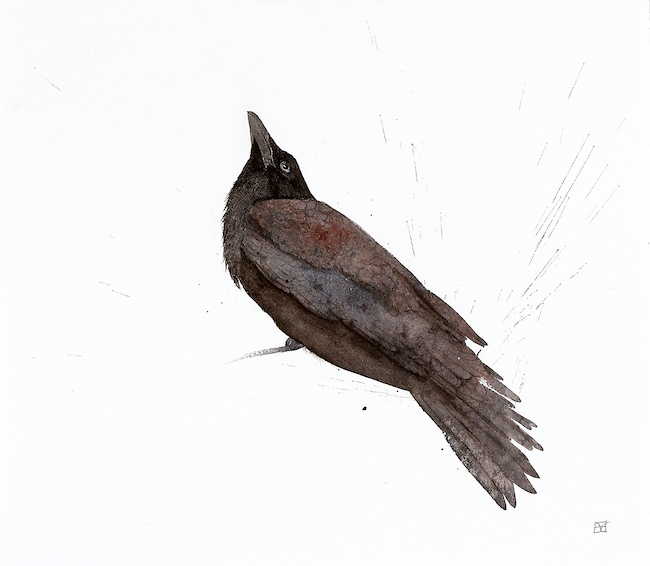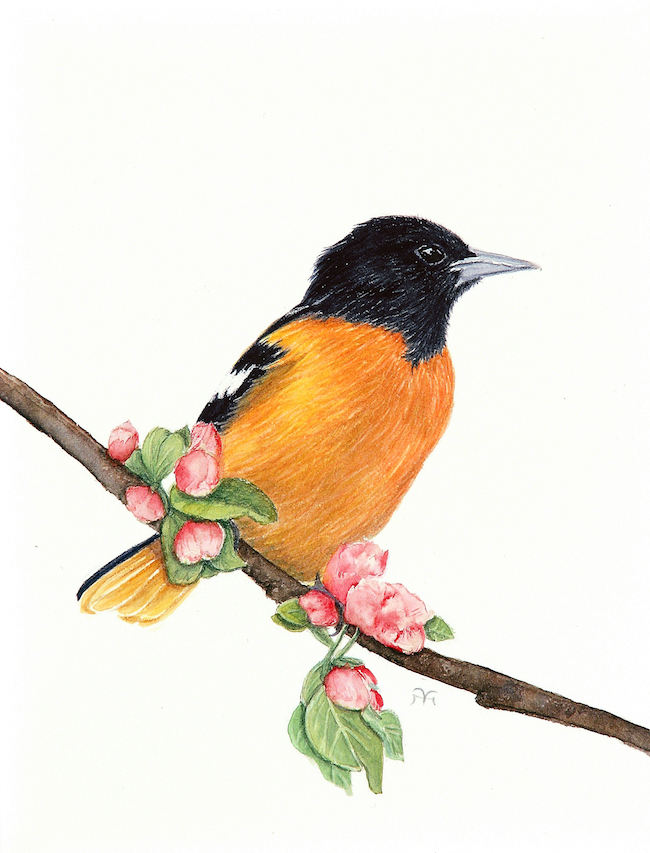 Tube blacks such as Ivory Black tend to be flat in tone and quite opaque, leaving our paintings looking dull.
Look at the variation of rich blacks I achieved in the crow above, and the depth of luminous back in the following three paintings of birds.
Tube blacks such as Ivory Black tend to be flat in tone and quite opaque, leaving our paintings looking dull.
Look at the variation of rich blacks I achieved in the crow above, and the depth of luminous back in the following three paintings of birds.


 If you follow these easy mixing techniques, you’ll be able to achieve the richest, darkest and most luminous blacks possible.
If you follow these easy mixing techniques, you’ll be able to achieve the richest, darkest and most luminous blacks possible.
Let’s get out our paints and practice mixing luminous, rich blacks.
For these exercises I used the following pigments by Daniel Smith:
- Hansa Yellow Light – a cool lemony yellow
- Quinacridone Rose – a cool magenta red
- Phthalo Blue GS – a cool blue
- New Gamboge – a warm golden yellow that leans toward orange
- Transparent Pyrrol Orange – a true transparent warm red
- French Ultramarine – a warm blue that leans toward red
- Burnt Sienna – a warm brown that leans toward orange
Mixing a deep, dark, cool black
 For this easy black that leans toward the cooler spectrum, we’ll use almost equal parts Hansa Yellow Light, Quinacridone Rose and Phthalo Blue GS. Here’s how:
For this easy black that leans toward the cooler spectrum, we’ll use almost equal parts Hansa Yellow Light, Quinacridone Rose and Phthalo Blue GS. Here’s how:
- With a wet brush, pick up plenty of Phthalo Blue and make a nice pool of pigment on a mixing plate.
- Then, rinse your brush, pick up an equal amount of the Quinacridone Rose and mix them together to create a really deep, rich violet.
- Finally, rinse your brush and pick up plenty of the Hansa Yellow Light and begin to mix them all together.
A deepest dark warm black
 For this luscious black we are using New Gamboge, Transparent Pyrrol Orange and French Ultramarine Blue.
Using the same technique described above, mix your three paints in nearly equal amounts until you arrive at a black like the one in the photo above, adjusting the different pigments as necessary.
These three warm pigments create a very deep and transparent black that works well for the foreground of your paintings. You can use both warm and cool blacks together to create beautiful nuances of hue in your work!
For this luscious black we are using New Gamboge, Transparent Pyrrol Orange and French Ultramarine Blue.
Using the same technique described above, mix your three paints in nearly equal amounts until you arrive at a black like the one in the photo above, adjusting the different pigments as necessary.
These three warm pigments create a very deep and transparent black that works well for the foreground of your paintings. You can use both warm and cool blacks together to create beautiful nuances of hue in your work!
A simpler mix
 For a very quick, easy, all-purpose black, mix equal amounts of Phthalo Blue GS and Transparent Pyrrol Orange. This combination is my very favorite for instant blacks and even deep, velvety grays with loads of luminosity and personality. Really a magical color combination!
For a very quick, easy, all-purpose black, mix equal amounts of Phthalo Blue GS and Transparent Pyrrol Orange. This combination is my very favorite for instant blacks and even deep, velvety grays with loads of luminosity and personality. Really a magical color combination!
A traditional mix
 Probably the most common two pigments for mixing luscious grays and true blacks are Burnt Sienna and French Ultramarine Blue. These two pigments are a watercolorist’s power couple.
Once you’ve created your black, try adding a little more water to your mix to see the beautiful variations of gray that can made from these two basic pigments.
It’s easy to get rich and luminous blacks with our most basic split-primary mixing palette!
Probably the most common two pigments for mixing luscious grays and true blacks are Burnt Sienna and French Ultramarine Blue. These two pigments are a watercolorist’s power couple.
Once you’ve created your black, try adding a little more water to your mix to see the beautiful variations of gray that can made from these two basic pigments.
It’s easy to get rich and luminous blacks with our most basic split-primary mixing palette!

Basic watercolor instructions